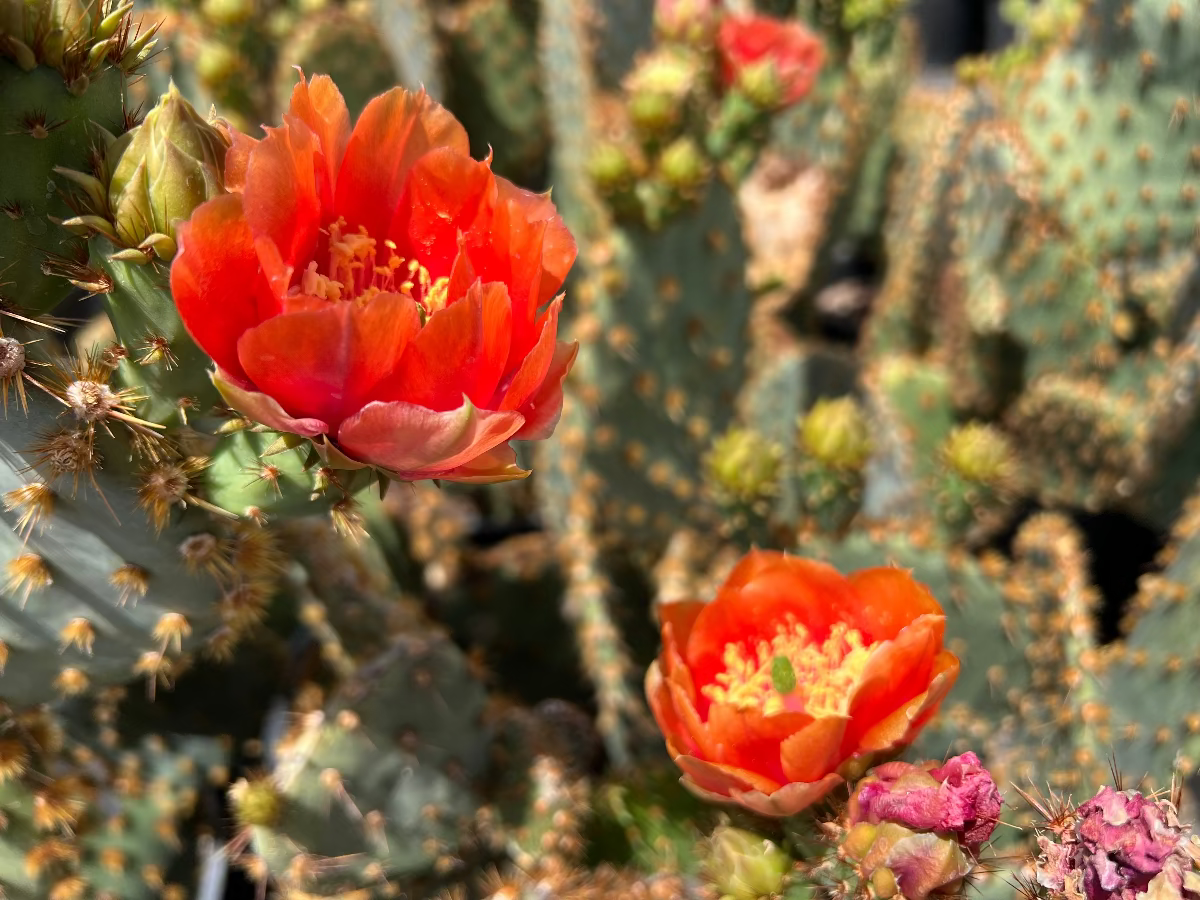My Store
Chenille Prickly Pear
Chenille Prickly Pear
Couldn't load pickup availability
Plant Type: perennial, shrubby prickly pear cactus
Plant Height: 3–5 feet (can reach 6 feet in maturity)
Spread: 5–8 feet
Flower Color: bright orange-red
Sun Exposure: Full sun
Chenille Prickly Pear / Opuntia aciculata: A Bold, Fiery Cactus with Velvety Texture and Desert Strength
Opuntia aciculata, commonly known as the Chenille Prickly Pear, stands out as one of the most vibrant and texturally intriguing prickly pears native to the American Southwest and northern Mexico. Its name “aciculata” refers to its fine, hair-like spines that give the pads a soft, chenille-like texture—an illusion that belies their sharpness. Known for its brilliant orange-red blooms and robust structure, this cactus brings fiery color and commanding form to any Arizona landscape.
Key Features of Opuntia aciculata
The Chenille Prickly Pear forms sprawling, upright clumps with oval to oblong pads that range in color from bright green to bluish-green depending on sun exposure and soil. Each pad is densely covered in small clusters of fine, hairlike spines (called glochids) that shimmer in sunlight, creating a soft and luminous appearance. In late spring through early summer, the plant bursts into a stunning display of large, cup-shaped orange-red flowers—often among the most vivid in the Opuntia genus. These blooms attract bees, butterflies, and hummingbirds, followed by small, reddish-purple fruits in late summer.
This species is highly adaptable and fast-growing, forming broad mounds that can serve as both ornamental features and living barriers. Its strong desert form and bold coloration make it a favorite for natural desert gardens and large-scale xeriscapes alike.
Growing and Care Tips
Opuntia aciculata thrives in full sun and gritty, fast-draining soil. It is one of the most heat-tolerant prickly pears, performing exceptionally well in Arizona’s harsh desert sun and reflective conditions. For best results, plant it on a mound or slope where excess water can drain quickly.
During the first few months after planting, water deeply but infrequently to help roots establish. Once established, this cactus requires little to no supplemental irrigation except during extended drought.
It is cold hardy to around 15°F, tolerating occasional frost without damage once mature. Prune sparingly, removing damaged pads with tongs or gloves. Avoid overhead watering, which can encourage fungal spots or rot in overly humid conditions.
In containers, choose a wide, shallow pot with a sharply draining cactus mix and gravel mulch to maintain airflow around the pads.
Landscaping Uses
The Chenille Prickly Pear adds dramatic height, texture, and color to desert landscapes. It’s ideal for accent plantings, rock gardens, and large desert borders, where its glowing pads and fiery flowers create striking contrast against neutral gravel and stone. Use it to complement Blue Glow Agave, Desert Spoon (Dasylirion wheeleri), or Golden Barrel Cactus for a balanced palette of cool blues and warm golds. Its fast growth and spreading habit also make it excellent for erosion control on slopes or as a natural security barrier.
In bloom, few desert plants can match the vivid impact of its orange-red flowers glowing in the Arizona sun.
Summary
The Chenille Prickly Pear (Opuntia aciculata) is a bold and resilient desert performer, combining glowing color with sculptural form. With its velvety texture, striking orange blooms, and ability to thrive in extreme heat, it’s both tough and beautiful—a perfect fit for Arizona landscapes that demand strength and style.
Three Timbers Installation Guide (Feel Free to Follow):
Opuntia aciculata Planting Guide:
Location: Full sun; choose a site with at least 8 hours of direct sunlight daily. Handles reflected heat well from walls, driveways, or boulders.
Soil: Use a sharply draining cactus mix blended with sand, decomposed granite, or pumice. Avoid clay-heavy or compact soils.
Spacing: Allow 6–8 feet between plants or structures to accommodate mature spread and airflow.
Planting Depth: Set pads level with or slightly above soil grade to prevent rot. Do not bury pads too deep—shallow planting promotes quick rooting.
Support: None required; the cactus will root and stabilize naturally under warm, dry conditions.
Watering Guide:
Watering After Planting: Water deeply once after planting to settle the soil. Then allow it to dry completely before watering again. During the first 3–4 months, water every 14–21 days depending on temperature and soil drainage.
When is the Plant Established? Opuntia aciculata is considered established after 6–9 months, once new pads form and color deepens.
Watering Once Established: Water every 4–6 weeks in summer if no rainfall occurs. In winter, water only during extended drought.
Drip Irrigation Setup: Install one low-flow emitter (1 gallon per hour) about 12–18 inches from the base, angled outward. Run sparingly and allow soil to dry fully between watering cycles.
General Watering Tips: Always verify soil dryness before watering again. Overwatering can cause pad rot and weak root systems. A gravel or decomposed granite top dressing helps stabilize soil, prevent splashing, and highlight the cactus’s rich color. Keep the base clear for airflow and long-term plant health.
Share


























